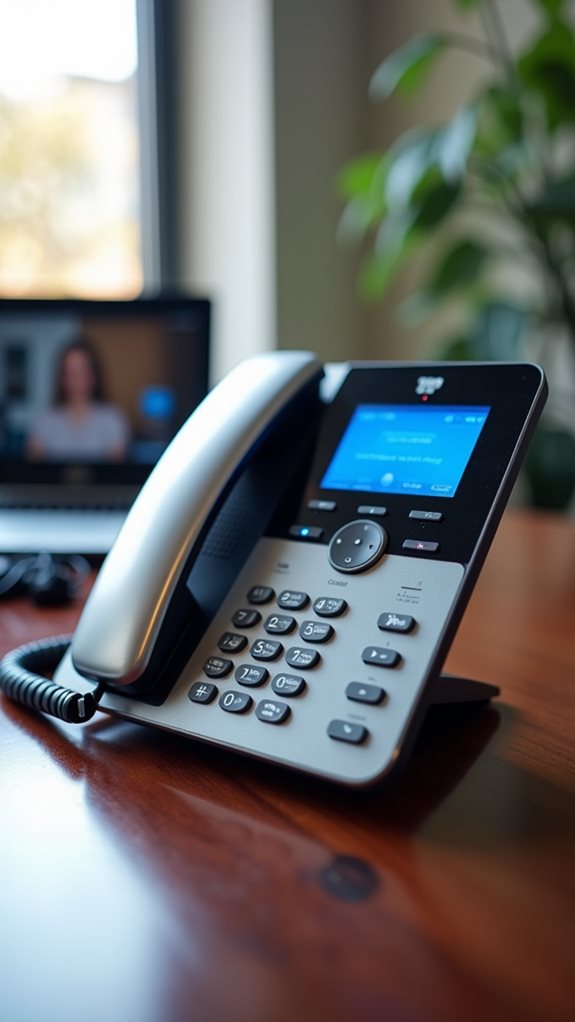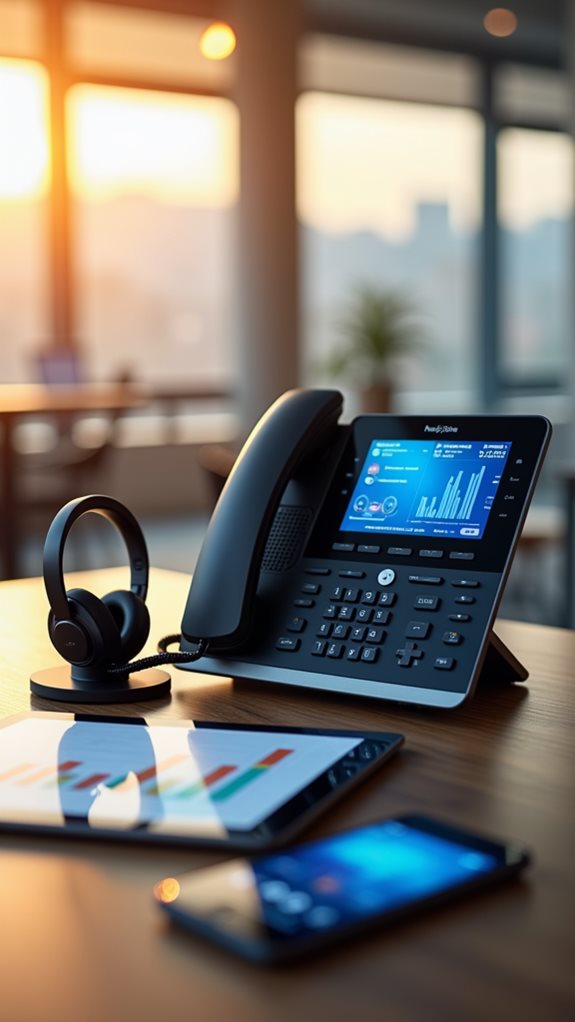VoIP technology revolutionizes business communications by transforming analog voice into digital data, offering up to 75% cost savings compared to traditional phone systems. You'll benefit from crystal-clear audio quality, advanced features like AI-powered tools, and seamless integration with business platforms, all while paying just $15-30 per user monthly. With enhanced security measures and 99.99% uptime guarantees, VoIP delivers a complete communication solution that scales effortlessly. Discover how these powerful capabilities can transform your business operations.
What Makes Voip Different From Traditional Phone Systems
While traditional phone systems have served businesses well for decades, VoIP technology represents a fundamental shift in how voice communications work.
You'll discover that VoIP benefits extend far beyond basic calling, transforming your analog voice into digital data that travels through the internet rather than copper wires. The technology delivers crystal clear audio that surpasses traditional phone lines.
Traditional limitations become apparent when you compare the hardware requirements. Your business calls will benefit from enhanced features like video conferencing and CRM integration.
While old-school systems demand extensive on-site equipment, you'll need minimal hardware with VoIP.
You're not just getting a phone system; you're accessing a complete communication platform that integrates with your favorite business tools.
Plus, you'll appreciate how VoIP lets you scale your system effortlessly, take your number anywhere, and enable your team to work remotely – features that traditional systems simply can't match.
The Real Cost Benefits of Switching to VoIP
As businesses scrutinize their operational costs more closely than ever, switching to VoIP presents a compelling opportunity to slash communication expenses by up to 75%.
You'll join countless other savvy companies discovering VoIP advantages, including predictable monthly bills ranging from just $15 to $30 per user, compared to traditional systems costing $40 to $50.
The cost efficiency of VoIP extends beyond basic savings. You're looking at reduced local call expenses by 40% and significant cuts in long-distance fees, averaging $1,727 less per month. Top providers like ULTATEL offer competitive international rates for businesses making frequent overseas calls, leveraging the significantly lower rates available through VoIP.
Plus, you'll benefit from unified communications that help your team save 30 minutes daily while eliminating the need for expensive equipment and setup costs. Currently, 31% of businesses have already recognized these advantages and made the switch to VoIP systems.
With cloud-based solutions continuing to drive prices down by 3-5% annually, there's never been a better time to make the switch.
Essential Features Every VoIP System Should Have

Modern VoIP systems come equipped with five fundamental features that'll transform your business communications. As a savvy business owner, you'll want advanced call management capabilities to handle your incoming calls efficiently, ensuring your customers never feel neglected. Additionally, many VoIP systems are designed to enhance operational efficiency, providing features that streamline communication processes.
Call recording isn't just a nice-to-have anymore – it's essential for training and quality assurance. To maintain optimal call quality, connecting through wired Ethernet instead of wireless networks ensures stable and reliable communications.
You'll also benefit from auto-attendants that professionally route your calls, conference bridges that bring your team together regardless of location, and customizable music on hold that reinforces your brand.
These features work together to create a professional image while streamlining your operations. When you're shopping for a VoIP system, make these your non-negotiables – they're the building blocks of effective business communication that'll keep you competitive in today's fast-paced market. The ability to make crystal-clear calls through HD quality communication ensures your message always comes through loud and clear.
Security Measures to Protect Your VoIP Communications
Securing your VoIP communications shouldn't feel like steering through a maze of technical jargon.
You'll want to protect your system from VoIP vulnerabilities, and we're here to help you navigate the essentials that every smart user should implement. Regular training helps employees spot and avoid phishing and vishing attempts targeting VoIP systems. Recent statistics show that 82% of breaches target cloud-based systems like VoIP. Additionally, ongoing training equips employees with the skills to identify new threats and adapt to evolving security landscapes.
Here are three critical security layers you can't afford to overlook:
- Implement multi-factor authentication and strong passwords to keep unauthorized users at bay.
- Encrypt your voice traffic using SRTP and guarantee your network undergoes regular security audits.
- Segment your VoIP network using VLANs and deploy session border controllers for enhanced protection.
How to Choose the Right VoIP Provider for Your Needs

Choosing the right VoIP provider can feel like maneuvering through a maze of endless options and technical specifications.
Let's clear up common VoIP misconceptions and focus on what really matters for your success.
When conducting service comparisons, you'll want to prioritize providers offering at least 99.99% uptime and extensive feature sets that align with your needs. Advanced features like call analytics help you monitor team performance and improve customer service quality.
Look for those delivering HD voice quality, reliable customer support, and seamless integration capabilities with your existing tools. Additionally, consider the importance of scalability to accommodate your business growth and evolving communication needs.
Don't forget to evaluate their pricing structure – the best providers offer transparent, scalable plans without hidden fees. The shift to VoIP solutions can result in 25% to 40% savings compared to traditional phone systems.
Setting Up Your VoIP System: A Practical Guide
Once you've selected your ideal VoIP provider, setting up your system requires careful attention to both technical requirements and practical considerations.
Your VoIP setup success depends on having the right infrastructure in place, including a robust network configuration that'll support clear, reliable communications.
Start with these essential steps:
- Verify your internet connection provides at least 100 kbps per line, keeping total VoIP usage under 80% of available bandwidth.
- Connect your IP phones using wired Ethernet cables rather than wireless connections.
- Configure QoS settings on your router to prioritize voice traffic over other data, as this will enhance VoIP performance for clearer calls.
Maximizing ROI With Advanced Voip Features

You'll find significant ROI potential by implementing auto-attendants that efficiently route calls and handle basic customer inquiries 24/7, reducing the need for additional staff.
Your remote teams can leverage VoIP's advanced features to maintain seamless communication while eliminating traditional office overhead costs, including phone systems and physical workspace expenses.
These strategic implementations can lead to substantial cost savings, with studies showing up to 60% reduction in communication expenses when compared to traditional phone systems. Additionally, the integration of advanced VoIP features can further enhance productivity and collaboration across teams.
Scaling Through Auto-Attendants
While businesses often struggle with managing high call volumes, implementing auto-attendants through VoIP technology offers a scalable solution that maximizes operational efficiency and return on investment.
The auto attendant benefits extend beyond basic call routing, allowing you to join the ranks of forward-thinking companies that prioritize customer experience.
Consider these scaling strategies that'll transform your communication infrastructure:
- Deploy intelligent call routing to reduce wait times and enhance customer satisfaction
- Implement 24/7 automated support to maintain constant availability without increasing staffing costs
- Utilize detailed analytics to optimize resource allocation and improve decision-making
You'll discover that auto-attendants aren't just about handling calls; they're about creating a professional image that grows with your business while maintaining personalized interactions your customers expect. Additionally, leveraging advanced features such as call forwarding and conferencing can significantly enhance your team's productivity and collaboration.
Remote Team Cost Savings
As businesses embrace remote work environments, VoIP technology stands out as a game-changing solution that dramatically reduces operational costs while maximizing team efficiency.
You'll discover immediate cost savings of 50-75% when switching to VoIP, with small businesses enjoying up to 40% reduction in local call expenses.
Your remote teams will benefit from the $1,200 average annual savings per employee, while integrated voice and web conferencing can cut your conferencing costs by 30%.
What's more, you're joining a growing community of forward-thinking businesses that are leveraging VoIP's advanced features to boost productivity by 20-30%.
With automated workflows, AI-powered tools, and seamless CRM integration, you'll transform your remote operations while keeping your budget in check.
It's no wonder VoIP adoption in remote teams surged by 47% in 2022. Additionally, the advanced features of VoIP, such as call analytics and virtual meetings, can significantly improve communication quality and customer service.
Frequently Asked Questions
Can I Keep My Existing Phone Number When Switching to Voip?
Yes, you can keep your existing phone number! Thanks to number portability regulations, you'll be able to transfer your current number to most VoIP providers. Just request porting during signup, and they'll handle the transfer.
What Happens to Voip Calls During a Power Outage?
You'll lose VoIP service during outages unless you've planned ahead. Your best defense is having a UPS backup and power alternatives like mobile apps, which let you continue making calls from your smartphone.
How Much Internet Bandwidth Do I Need per Voip Line?
You'll need around 100 kbps of internet speed per VoIP line for ideal quality. For your bandwidth requirements, plan on dedicating at least 90-100 kbps per line to guarantee clear, reliable calls.
Does Voip Call Quality Depend on Weather Conditions?
Yes, weather can impact your VoIP call quality. You'll notice call distortion during electrical storms, and severe weather affecting internet connectivity. However, you can minimize these issues by using wired connections and quality equipment.
Can I Use My Voip System Internationally Without Additional Charges?
You'll need to check your VoIP provider's policies, as international usage often incurs extra charges. However, you can use call forwarding and internet-based apps to minimize costs while staying connected abroad.
Final Thoughts
You're now equipped with the essential knowledge to make an informed VoIP shift. By understanding the technology's fundamentals, cost benefits, security requirements, and advanced features, you'll confidently navigate the selection and implementation process. Remember to prioritize your specific needs when choosing a provider, and don't hesitate to leverage the system's full capabilities. With proper setup and management, your VoIP investment will deliver substantial long-term value and communication efficiency.

